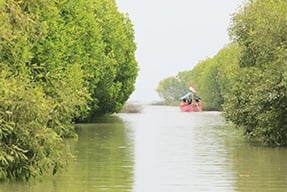Described below is the summary of Q&A session with institutional investors and securities analysts at the FY2011 3Q results conference call held on February 14, 2012.
- Q1You said that the latest estimate of net incurred loss related to Thai Flood is approximately ¥110 billion. The revision seems relatively small compared with those of other domestic insurance groups, considering the previous estimate of ¥100 billion announced in November 18, 2011. How have you changed the way you estimate the loss between the two?
- A1
The previous loss estimate, while the loss situation was not clear enough with drainage works still under way, was obtained under the assumption based on past accumulated data that the damageability-ratio would be approximately mid-fifties. We almost completed on-site survey and loss assessments by the end of December 2011. The revised loss estimate we announced today reflects our latest information including those survey reports, and we confirmed that the damageability-ratio in total has hardly changed from the original assumption. There were two main factors which caused changes in the estimated loss:
i) Recording of additional losses newly recognized in property insurance (including business interruption insurance), cargo insurance, and other insurance lines at Tokio Marine & Nichido and other subsidiaries
ii) Reviewing recoverable amount from ceded reinsurance, considering losses for each insurance policy.
Regarding our smaller revision as compared with other domestic insurance groups, we have been carefully monitoring changes in incurred loss after the end of December, and there has been almost no change from the revised loss estimate to this date.- Q1(2)How much do you estimate the claims payment for business interruption insurance?
- A1(2)
In the revised estimate announced today, we included all losses for business interruption insurance that are known at present. However, we would not rather disclose the loss amount which is derived exclusively from business interruption insurance since majority of such insurance is underwritten as part of fire insurance and therefore there are some difficulties in identifying the exact loss amount.
- Q2It seems that reinsurance costs to transfer domestic and overseas natural catastrophe risks are increasing owing to frequent occurrence of natural catastrophes such as Thai Flood. Are you successfully shifting the increased cost to customers in primary business?
- A2
Since reinsurance contracts for domestic risks are normally renewed in April, the potential extent of the reinsurance premium hike is still unclear at this point. As you pointed out, reinsurance rates for Thailand are increasing owing to Thai Flood losses, but the impact of such reinsurance cost on our group's total business would be quite limited. Furthermore, we have already altered our primary underwriting policies and believe that we can ensure sufficient profitability to absorb the increased reinsurance cost.
- Q3There seems to be some delay in claims payment relating to Thai Flood, since reversal of catastrophe loss reserve was reduced from the original projection owing to the reviewed progress of the claims payment. Please tell us the amount paid at present and your payment forecast for the next fiscal year.
- A3
Tokio Marine & Nichido has recorded ¥1.8 billion of net claims paid as at the end of 3Q FY2011, and approximately ¥15.0 billion is estimated to be paid for full year based on an assumption that Tokio Marine & Nichido will pay approximately 30% out of around ¥50.0 billion of domestic incurred losses for FY2011. Instead of setting a specific target of progress in claims payment, we continue working with customers to reach a reasonable consent before closing the payment processing.
- Q4A significant decrease is expected in the balance of catastrophe loss reserve as a result of frequent occurrence of natural catastrophes. Do you have any plan to give priority to accumulate internal reserves hereafter?
- A4
We are going to consider an appropriate level of internal reserves, based on renewal conditions of reinsurance contracts for domestic risks and other factors, which are to be determined by April. However, no major change is planned at present as we still have a sizable amount of catastrophe loss reserve.
- Q5Kiln recorded an increase in net premiums written on a local currency basis. Was it due to the hardening of current reinsurance market?
- A5
The main factor for Kiln's premium increase was a growth in selected accounts of Lloyd's Syndicate businesses. There was a steady growth mainly in property insurance and marine insurance. As you mentioned, the reinsurance rate is in an upward trend since this January, however, we expect its positive effect on earnings to be seen in FY2012 and beyond.
- Q6With regard to domestic auto insurance, favorable results of 1.1% YoY premium increase was recorded for the nine months ended December 31, 2011. How much premium increase YoY do you roughly expect in the next fiscal year and beyond, in light of the products and rate revisions implemented in January 2012 and the new grade rating system to be introduced sometime in autumn 2012?
- A6
In January 2012, we conducted rate revisions aiming at profitability improvement, in addition to introducing "a new rate schedule differentiated by age bracket" in which rate is determined by the age of the named insureds. We expect positive effects of these two initiatives hereafter. As for the new grade rating system, its introduction is expected to mitigate structural decrease in per-auto premium over years. Though we are preparing its introduction sometime in autumn 2012, its effect on premium growth will be seen one year after the introduction.
- Q7As for the sales of business-related equities, please tell me 3Q results and full-year projections.
- A7
We sold approximately ¥120 billion of business-related equities as at the end of 3Q, and for the full fiscal year, the total sales will be about the same level as in FY2010.
- Q8Please tell us the E/I loss ratios excluding the impact of natural catastrophes.
- A8
Excluding the impact of natural catastrophes, the E/I loss ratios on a private insurance basis were as follows: 36.7% in Fire, 47.4% in Marine, 53.1% in PA, 69.6% in Auto, 51.9% in others, and 59.6% in total.
- Q9What is the nature of the impairment losses on securities recorded in 3Q FY2011?
- A9
There was an impairment loss on a limited number of our large stock holdings as a result of drop in stock prices.
- Q10Tokio Marine Holdings seems to be making a steady progress in the sales of business-related equities ahead of other domestic insurance groups. Isn't there any difficulty or negative impact on your business as a result of that initiative?
- A10
Through thorough communication, we have secured customers' consents and agreements on selling business-related equities with a long-term perspective so that our selling won't negatively affect customers' stock prices. As long as we keep this policy, there should be no major negative impact on our business.
- Q10(2)I would like to confirm that Tokio Marine Holdings will be aiming at sales of business-related equities in the range from ¥150.0 billion to ¥200.0 billion, also for FY2012. Is this understanding correct?
- A10(2)
We will announce our FY2012 plan for sales of business-related equities at the announcement of FY2011 financial results. At present, there is no change to our general direction on sales of business-related equities.
- Q11Regarding the rate increase in reinsurance market caused by frequent natural catastrophes, are there any regional characteristics in the trend? Also, I assume that this rate increase could be a growth opportunity for your reinsurance business. What kind of effects can be seen on your reinsurance business at present?
- A11
Regarding overseas risks, there certainly is a moderate increase in reinsurance rates, in particular for the risks of natural disasters in the U.S. at present. In the reinsurance market as a whole, however, reinsurance companies still maintain sufficient capital level and therefore the rate increase due to the supply and demand balance in the market has not yet occurred.
With respect to the risks other than natural disasters, although markets for some lines are getting more competitive, we will work for risk diversification and profitability improvement by expanding our business into those areas.- Q11(2)How are the financial results of new branch offices opened by Tokio Millennium Re (TMR)?
- A11(2)
We established new branches in Switzerland and Australia aiming at acquisition of new business and global risk diversification. Earnings of these branches were about ¥1.0 billion in total in 3Q FY2011, and which is in line with our business plans.
- Q12Regarding Thai Flood, I assume that, in many cases, the liabilities for insurance claims are co-insured by Japanese insurance companies. Why is Tokio Marine Group's estimated loss smaller than those of other domestic insurance groups?
- A12
Although we do not know about other companies' situations, we estimated the loss taking into consideration of the reports from loss adjusters who assessed the damage on site as well as the total insured exposure. We do not think that our loss estimate lack major elements which should be included at present.
- Q13Are you accelerating the sales of business-related equities in order to restore the level of internal reserves in the medium to long term which was lowered by natural catastrophes and business investments? Or, are you pursuing the target sales amount set for the current fiscal year?
- A13
Both are in our consideration. There is no change not only to our yearly sales target of business-related equities announced at the beginning of FY2011, but also to the policy to accelerate the sales for improving capital efficiency.
- Q13(2)At present, is there any acceleration in negotiations with customers or any increase in the sales amount regarding the sales of business-related equities?
- A13(2)
Sales of business-related equities are arranged maintaining close communications and long-term relations with customers, and there has been no change in our policy.
- Q14The effect of reduction in non-personnel expenses was factored in the Tokio Marine & Nichido's revised projections announced today. Are you carrying over the expenses originally planned to be paid in the current fiscal year into the next fiscal year, or, was the reduction achieved by your cost-cutting efforts?
- A14
The decrease in non-personnel expenses was achieved through our cost-cutting effort and not caused by the time-lag of recording the expenses. Therefore, it will not become a factor to increase non-personnel expenses in FY2012.
- Q15Please tell us the reversal amount of underwriting reserves for residential earthquake insurance and CALI in line with the corporate tax reduction. Under which item of account was it recorded?
- A15
The total reversal amount was ¥15.4 billion; ¥13.6 billion at Tokio Marine & Nichido and ¥1.7 billion at Nisshin Fire. They were recorded under the accounting item of "Reversal of underwriting reserves."
- Q16Assuming that the next mid-term corporate strategy for the next three years being discussed at Tokio Marine Holdings, I am wondering if you could tell us a potential direction regarding return to shareholders or ROE target.
- A16
Although we are not yet ready to describe the details, we are considering current business performance and the future trends of each business, such as profit recovery of domestic non-life, steady growth in domestic life, and the growth of international business in order to deliberate the framework for shareholder return and ROE target, together with a proper review of the current mid-term corporate strategy.
- Q16(2)I have a sense that you are going to target 7% of adjusted group ROE. Is my understanding correct?
- A16(2)
Under the current mid-term corporate strategy, we have been aiming for the ROE which exceeds the capital cost. We are going to draw up the next mid-term corporate strategy keeping this into consideration.
These information materials are prepared based on the currently available information for us and described subject to our predictions and forecasts carried out at the time of preparation.
It must be noted that what is described therein does not guarantee our future business performance and carries certain risk of misjudgment or uncertainty.
Accordingly, you are kindly requested to bear in mind that there may be a possibility of sizable divergence between the actual business performance in the future and that of our predictions or forecasts described therein.





